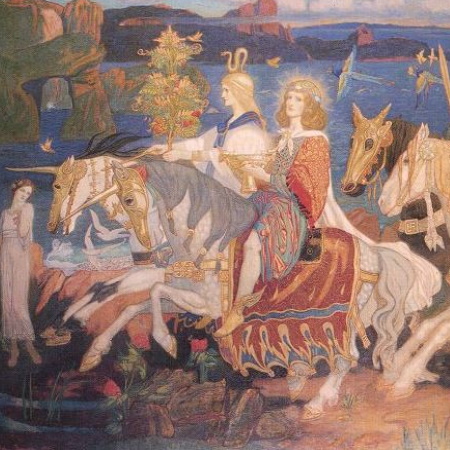The untruths we learned from the art of the Victorian Celtic revival. By Sarah Corbett
The Celts were a branch of the Indo -Europeans.
Proto Celtic people from the Balkans came to Central Europe in 2500 BC
The earliest major Celtic settlement was in Hallstatt, Austria.
The name Celt is derived from the Greek word Keltoi, meaning Barbarian. Those referred to by this name were not of one culture, but a mixture of groups, each distinct in origin. The cultural identity of these diverse people has become blurred in the consciousness of many.
But why and when do these historical facts become changed to the impression we have of Celtic origin today.
A rise in nationalism in Ireland in the mid to late 18th Century inspired a romantic revival of the Celtic culture, looking for ancient roots, artists and writers reworked legend into fact. In doing so they created a new story. This wave of revivalist activity continued in Scotland into the early 20th Century.
The modern art movements of the time such as Arts and Crafts were firmly rooted in Celtic styling.
The symbols they reused were considered to be evocative of what it was to be Irish or Scottish Celts, when in fact much of the styling used was really from elsewhere.
An example of this is the intricate interlaced (knot work) which is widely described as a Celtic art form, but in fact it’s roots are Germanic, and were present in Anglo Saxon art.
A famous painting called ‘Riders of the Sidhe’ by John Duncan ( 1866 – 1945) was one of the key artists in the ‘Celtic revival movement’.
The painting is filled with wondrous adornments, all of which became synonymous with the wider awareness of Celtic adornment; however the truth is that the adornments depicted are from diverse locations and cultures: We see Helmets which are of Greek style, the pony masks with unicornesque spikes are Austrian designs. The shield is inspired by the Battersea shield found in the Thames, and the longsword from the La Tene culture of Central Europe. The chalice is a purely Mycenaean form.
We clearly are seeing only a vision created from the imagination of an artist who claimed to enter a trance whilst painting, and to use his inner eye to enter a realm of fantasy. During these phases he also claimed to hear fairy music. Yet from his images a romantic concept of the styles and forms of Cetlic culture has been accepted into the public consciousness.
Art and beauty have led us astray.
Tags: art and lies, material culture, the celts, victorian revival






